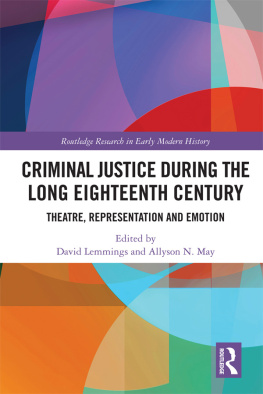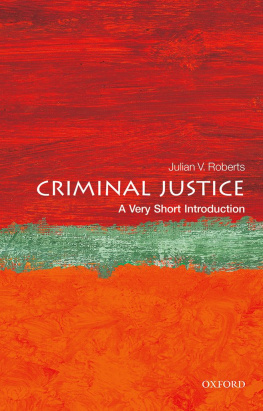Criminal Justice During the Long Eighteenth Century
This book applies three overlapping bodies of work to generate fresh approaches to the study of criminal justice in England and Ireland between 1660 and 1850. First, crime and justice are interpreted as elements of the public sphere of opinion about government. Second, performativity and speech act theory are considered in the context of the Anglo-Irish criminal trial, which was transformed over the course of this period from an unmediated exchange between victim and accused to a fully lawyerised performance. Third, the authors apply recent scholarship on the history of emotions, particularly relating to the constitution of emotional communities and changes in emotional regimes.
David Lemmings is Professor of History at the University of Adelaide and Leader of the Change Program in the ARC Centre of Excellence for the History of Emotions.
Allyson N. May is Associate Professor in the Department of History at the University of Western Ontario.
Routledge Research in Early Modern History
Women and Jewish Marriage Negotiations in Early Modern Italy
For Love and Money
Howard Tzvi Adelman
Piracy and Captivity in the Mediterranean
15501810
Edited by Mario Klarer
The Reformation of Englands Past
John Foxe and the Revision of History in the Late Sixteenth Century
Matthew Phillpott
Science in an Enchanted World
Philosophy and Witchcraft in the Work of Joseph Glanvill
Julie Davies
The English Chartered Trading Companies, 16881763
Guns, Money and Lawyers
Michael Wagner
Enlightenment in Scotland and France
Studies in Political Thought
Mark Hulliung
The School of Salamanca in the Affairs of the Indies
Barbarism and the Political Order
Natsuko Matsumori
Criminal Justice During the Long Eighteenth Century
Theatre, Representation and Emotion
Edited by David Lemmings and Allyson N. May
For more information about this series, please visit: www.routledge.com/Routledge-Research-in-Early-Modern-History/book-series/RREMH
Criminal Justice During the Long Eighteenth Century
Theatre, Representation and Emotion
Edited by David Lemmings and Allyson N. May
First published 2019
by Routledge
52 Vanderbilt Avenue, New York, NY 10017
and by Routledge
2 Park Square, Milton Park, Abingdon, Oxon OX14 4RN
Routledge is an imprint of the Taylor & Francis Group, an informa business
2019 Taylor & Francis
The right of the editors to be identified as the authors of the editorial material, and of the authors for their individual chapters, has been asserted in accordance with sections 77 and 78 of the Copyright, Designs and Patents Act 1988.
All rights reserved. No part of this book may be reprinted or reproduced or utilised in any form or by any electronic, mechanical, or other means, now known or hereafter invented, including photocopying and recording, or in any information storage or retrieval system, without permission in writing from the publishers.
Trademark notice: Product or corporate names may be trademarks or registered trademarks, and are used only for identification and explanation without intent to infringe.
Library of Congress Cataloging-in-Publication Data
A catalog record for this title has been requested
ISBN: 978-0-367-02500-7 (hbk)
ISBN: 978-0-429-39922-0 (ebk)
Typeset in Sabon
by Apex CoVantage, LLC
Contents
DAVID LEMMINGS AND ALLYSON N. MAY
Part I
Feminine Performances and the Criminal Trial: Womens Emotional Work in the Public Sphere
DANA RABIN
ANDREA MCKENZIE
E.J. SNELL
Part II
Emotional Communities and Sensibilities: Truth, Theatre, and Blasphemy in Court
KATIE BARCLAY
SIMON DEVEREAUX
ALLYSON N. MAY
Part III
Emotional Regimes and the Legal Process: Stories of Terror, Sensibility, and Patriotism in the Representation of Criminal Trials
HAL GLADFELDER
RANDALL MCGOWEN
DAVID LEMMINGS
This book originated in a Symposium held at the Henry E. Huntington Library on 12 November 2013. The editors are grateful to Dr. Steve Hindle, Director of Research at the Huntington, for supporting this event, and for his hospitality. We are also indebted to the Australian Research Council Centre of Excellence for the History of Emotions (CE110001011) for helping to fund the Symposium. Thanks are also due to Max Novick and Jennifer Morrow at Routledge for helping to turn a conference into a book.
David Lemmings and Allyson N. May
[A]midst shame and misery I yet wish to live; and most humbly implore that I shall be recommended by your lordship to the clemency of his majesty.
(Dr. Dodds Speech, which He Delivered to the Judge, before receiving Sentence of Death (London, 1777), broadsheet)
Background, Aims, and Themes
With these words and appropriate tears, the unfortunate Dr. William Dodd appealed for mercy after being convicted of forgery at the Old Bailey in 1777. In these ways this collection seeks to contribute new cultural-historical and theoretical perspectives to the history of the English criminal trial process, which has previously been dominated by the pioneering work of social and legal historians.
The background to this collection of essays consists of three overlapping bodies of work, which are fruitfully applied to generate a fresh approach to the study of crime and criminal justice in Britain over the period 16601850. Firstly, crime and justice news has been interpreted through the conceptual lens of the public sphere (i.e., printed reportage and commentary about public affairs), inspired originally by Jrgen Habermas, but developed in recent studies of early modern British history.4 Thus the reporting of crime and punishment in the press may be regarded as a media conversation among stakeholders about the merits of law and justice, rather than an accurate representation of events.5 Secondly, performativity and speech act theory are related to the special historical context of the Anglo-Irish criminal trial, which was transformed over the course of this period from an unmediated exchange between victim and accused to a progressively lawyerised performance culture.6 And thirdly, the authors take account of recent scholarship on the history of emotions, particularly relating to the constitution of emotional communities, changes in emotional regimes, and also press representations of scandalous events and their implications for popular participation in public affairs.7 Indeed, all these genres regard collective emotions and their cultural contexts as fundamentally important for constituting moral identities and driving historical change. In this book their complementary theoretical and empirical perspectives are applied to crime and justice proceedings: an important site of British government at the interface of state and society.
Emotions and Change: A Cultural History of Performance
So progressing the history of crime and punishment means attending to the performance of emotions, particularly to the formation of emotional communities, and shifts in emotional regimes, through close readings of relevant print culture and their implications for popular feelings about public affairs.8 As suggested in Dodds case, his semi-religious repentance may be regarded as a speech act: an emotional display which ideally could convene an emotional community of sympathetic auditors and readers. As such, it had the potential to subvert the dominant emotional regime of the state, the majesty of criminal justice. The essays that follow consider criminal trials and punishment as performances in two different but related senses. First, like Erving Goffmans classic,






